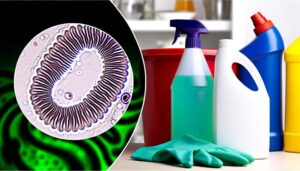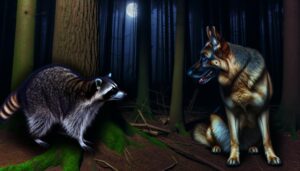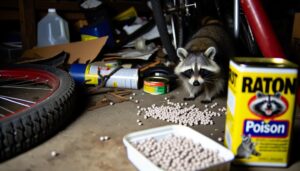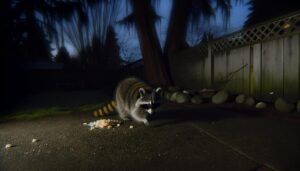Does Raccoon Pee Kill Grass?
Raccoon urine can adversely affect grass due to its high nitrogen content and various chemical compounds. The nitrogenous compounds, particularly urea, convert to ammonium and nitrate, leading to nutrient imbalances and potential root damage.
Sulfur-containing compounds contribute to soil acidification, which can result in phytotoxicity. Typical signs include yellowing or browning patches of grass, indicating chemical stress and disrupted chlorophyll production.
These impacts highlight the importance of understanding the biochemical changes induced by raccoon urine on soil and plant health. For strategies on mitigating these effects and promoting lawn recovery, explore further insights.
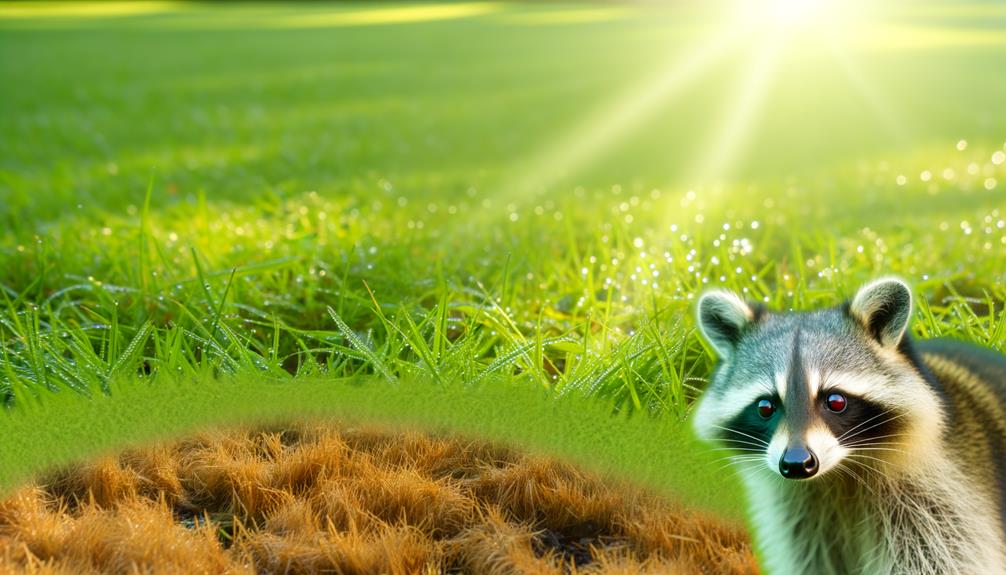
Key Takeaways
- Raccoon urine contains high levels of nitrogen, leading to nutrient imbalances and root damage in grass.
- Excess nitrogen from raccoon urine disrupts chlorophyll production, causing yellowing or browning patches in grass.
- Sulfur-containing compounds in raccoon urine contribute to soil acidification, negatively impacting grass health.
- Biochemical changes from raccoon urine can result in phytotoxicity, causing necrotic tissue and reduced root integrity.
- Grass exposed to raccoon urine may experience nutrient imbalances, chemical stress, and altered soil pH, harming overall lawn health.
Understanding Raccoon Behavior
Raccoon behavior, particularly their foraging and territorial marking habits, can greatly impact plant health and soil composition. Foraging raccoons often dig up soil and disturb root systems while searching for food, which can lead to reduced plant vigor and increased susceptibility to disease.
Their territorial marking, typically through urine and feces, introduces nitrogen-rich compounds into the soil. Studies indicate that while moderate nitrogen levels can benefit plant growth, excessive nitrogen from repeated marking may lead to nutrient imbalances, soil acidification, and root damage. This can result in reduced plant biomass and altered plant community composition.
Understanding these behaviors is essential for developing effective management strategies to protect vegetation and maintain soil health in raccoon-affected areas.
Chemical Composition of Raccoon Urine
The chemical composition of raccoon urine is mainly characterized by high levels of nitrogenous compounds, such as urea, creatinine, and ammonium, which can greatly influence soil chemistry and plant health.
Urea rapidly hydrolyzes in the soil, converting to ammonium and subsequently to nitrate, both of which are essential but potentially harmful in concentrated amounts. Elevated nitrogen levels can disrupt soil pH, leading to an imbalance in nutrient availability.
Additionally, the presence of sulfur-containing compounds and various organic acids in raccoon urine may further contribute to soil acidification and osmotic stress. These biochemical changes can result in phytotoxicity, affecting root function and overall plant vigor.
Therefore, understanding the chemical intricacies of raccoon urine is essential for evaluating its impact on grass and soil health.
Identifying Damage to Grass
Observing the initial symptoms of grass damage involves identifying yellowing or browning patches, often indicative of nutrient imbalances or chemical stress. Such discoloration can result from various factors, including raccoon urine, which contains high concentrations of nitrogen and other chemicals. Excess nitrogen can cause localized 'burns' on the grass, disrupting chlorophyll production and impairing photosynthesis.
Additionally, the presence of urea and other compounds in raccoon urine can alter soil pH, further inhibiting grass health. Close examination of the affected areas may reveal necrotic tissue and reduced root integrity, hallmarks of chemical stress. Monitoring these symptoms is crucial for diagnosing the specific cause and implementing appropriate remediation strategies to restore grass strength and mitigate ongoing damage.
Preventing Raccoon Visits
Implementing effective deterrent strategies is essential for preventing raccoon visits and safeguarding lawn health. Evidence-based approaches include:
- Physical Barriers: Installing fences with a minimum height of 3 feet and buried at least 6 inches underground can prevent raccoon entry. Electric fencing may offer additional protection.
- Chemical Deterrents: Utilizing commercial raccoon repellents containing capsaicin or ammonia can discourage raccoons from frequenting the area. Reapply after rain for sustained efficacy.
- Habitat Modification: Removing food sources such as bird feeders, pet food, and securing garbage bins can make your lawn less attractive to raccoons. Additionally, trimming overgrown vegetation minimizes potential hiding spots.
These methods collectively contribute to a raccoon-free environment, promoting healthier grass and a well-maintained lawn.
Lawn Recovery Tips
Revitalizing a lawn affected by raccoon activity involves targeted aeration, soil amendments, and reseeding techniques to restore grass health and density.
Begin by aerating the compacted soil to enhance root penetration and water infiltration. Apply organic matter such as compost to improve soil structure and nutrient content. Test soil pH and amend accordingly, using lime to raise pH or sulfur to lower it.
Select grass seed varieties that match the existing lawn's species and climate suitability. Distribute seeds evenly and lightly rake the surface to ensure good seed-to-soil contact. Water the area consistently to maintain moisture levels conducive to germination and root development.
Implement a balanced fertilization schedule to support vigorous growth and resilience against future disturbances.
Conclusion
The chemical composition of raccoon urine, rich in nitrogen and other compounds, can cause significant damage to grass, akin to the way excessive fertilizer burns plant roots.
Observations of lawns where raccoon activity is prevalent reveal patchy, discolored areas, underscoring the detrimental effects.
Implementing preventive measures and adopting recovery techniques can mitigate these impacts.
Just as a balanced nutrient regimen promotes plant health, managing wildlife interactions is essential for maintaining robust, verdant lawns.

